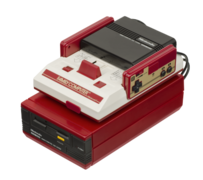Nintendo Family Computer
| Nintendo Family Computer | ||
|---|---|---|
|
|
||
 
|
||
| Manufacturer | Nintendo | |
| Type | stationary game console | |
| generation | third generation of consoles | |
| publication |
|
|
| Main processor | Ricoh 2A03 8-bit processor ( MOS Technology 6502 core) | |
| Storage media | Modules | |
| Controller | 2 hardwired + 1 port on the front of the device; Famicom controller | |
| Units sold | unknown | |
| successor | Super Famicom / SNES | |
| info | Japanese variant of the NES | |
The Nintendo Family Computer ( Japanese フ ァ ミ リ ー コ ン ピ ュ ー タ Famirī Konpyūta 'family computer '), Famicom for short ( フ ァ ミ コ ン Famikon ), is a stationary game console from the Japanese company Nintendo , which was released on July 15, 1983 in Japan and the Japanese version of the Nintendo Entertainment System is. The Famicom is visually reminiscent of the 1991 SNES , which was called Super Famicom in Japan. There was also a popular additional drive called the Famicom Disk System .
Nintendo wanted to release the console in the United States , but many companies turned down the offer. So Nintendo decided to do the publishing all by itself. However, in order to get the stores to offer the console at all, Nintendo had to promise dealers to buy back any unsold units.
Nintendo advertised the console and entertainment system (to German about entertainment system ) so as to appeal to the American market. In addition, the name was changed from Famicom to Nintendo Entertainment System (NES). The design of the NES differs considerably from the design of the Famicom, however, it is more reminiscent of the mouse-gray consumer electronics devices available at the time, whereby the insertion of the game cartridges behind a flap should no longer be reminiscent of past video game systems with outstanding plug-in modules.
Differences to the NES
In contrast to the NES, the Famicom is a so-called “top loader”. This means that the modules are not plugged into the front, but directly onto the pin connector. While the NES sends the data to the motherboard via detours, there is a direct connection here. The dreaded "blinking" is thus decimated. To make it easier to replace the modules, a slide is mounted in the middle of the Famicom, which ejects the game module when activated. Another reason for having plug-in modules is the lack of any regional restrictions. So-called “lock-out chips” were not used. This enables almost error-free use of the console even today. With the help of a few adapters, almost every American or European game module can be used. PAL versions can therefore be played at the original speed of 60 Hz if they are not adapted. Only a fraction of the games that have been published in Europe have a real adaptation to the PAL standard (for example Zelda II, Super Mario Bros, Tetris). Since the original Famicom only has one antenna output, modifications are necessary for operation in this country in order to convert the NTSC signal into the PAL format predominant in this country. Furthermore, a suitable power supply unit is required for operation because the original Famicom power supply unit is only designed for 100 volts mains voltage .
With the Famicom, the two controllers are permanently wired to the device and only the first controller has a START + SELECT button each. The second controller, on the other hand, has a built-in microphone that is used in a few games. Additional controllers and a multitude of exotic accessories can be connected via the front expansion port. Only the New Famicom, released in 1993, has the two controller connections known from the NES on the front. The expansion port has been shifted to the right.
Web links
- Famicom World - consoles, games, prototypes, reviews, etc. a.
- Article on ConsoleDatabase.com
- Famicom and clones in the Ultimate Console Database







